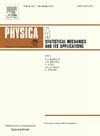Correlations between two vortices in dry active matter
IF 2.8
3区 物理与天体物理
Q2 PHYSICS, MULTIDISCIPLINARY
Physica A: Statistical Mechanics and its Applications
Pub Date : 2024-11-12
DOI:10.1016/j.physa.2024.130181
引用次数: 0
Abstract
It was recently shown that wet active matter can form synchronized rotating vortices in a square lattice, similar to an antiferromagnetic Ising model (by considering rotation direction as spin projection). In this study, we investigate whether such a correlated state occurs for a model of dry active matter. We achieve that by numerically simulating the dynamics of a system of active particles in the presence of two identical circular obstacles. Then, we measure the angular velocity correlation function of both vortices as a function of the obstacle diameter, their shortest separation (gap), and the particle density. When the correlation function is negative, both vortices rotate in contrary directions. They maintain this state by exchanging particles through the region between them, analogously to synchronized cogs. On the other hand, with a positive correlation function, a single rotating cluster emerges, and the particles move around the whole structure, similar to a belt strapped around the obstacles. Additionally, we observe the emergence of uncorrelated states at the transition between correlated states, in which only a single vortex is present, or in the large gap regime, in which the vortices are nearly independent on each other.
干活性物质中两个涡旋之间的相关性
最近的研究表明,湿活性物质可以在方形晶格中形成同步旋转涡旋,类似于反铁磁性伊辛模型(将旋转方向视为自旋投影)。在本研究中,我们将研究干活性物质模型是否会出现这种关联状态。为此,我们对存在两个相同圆形障碍物的活性粒子系统的动力学进行了数值模拟。然后,我们测量了两个涡旋的角速度相关函数与障碍物直径、它们的最短间隔(间隙)和粒子密度的函数关系。当相关函数为负时,两个漩涡向相反的方向旋转。它们通过在两涡之间的区域交换粒子来维持这种状态,类似于同步齿轮。另一方面,如果相关函数为正,则会出现一个单一的旋转簇,粒子在整个结构中移动,类似于在障碍物上绑上皮带。此外,我们还观察到在相关态之间的过渡阶段出现了非相关态,此时只有一个涡旋存在,或者在大间隙状态下,涡旋几乎是相互独立的。
本文章由计算机程序翻译,如有差异,请以英文原文为准。
求助全文
约1分钟内获得全文
求助全文
来源期刊
CiteScore
7.20
自引率
9.10%
发文量
852
审稿时长
6.6 months
期刊介绍:
Physica A: Statistical Mechanics and its Applications
Recognized by the European Physical Society
Physica A publishes research in the field of statistical mechanics and its applications.
Statistical mechanics sets out to explain the behaviour of macroscopic systems by studying the statistical properties of their microscopic constituents.
Applications of the techniques of statistical mechanics are widespread, and include: applications to physical systems such as solids, liquids and gases; applications to chemical and biological systems (colloids, interfaces, complex fluids, polymers and biopolymers, cell physics); and other interdisciplinary applications to for instance biological, economical and sociological systems.

 求助内容:
求助内容: 应助结果提醒方式:
应助结果提醒方式:


